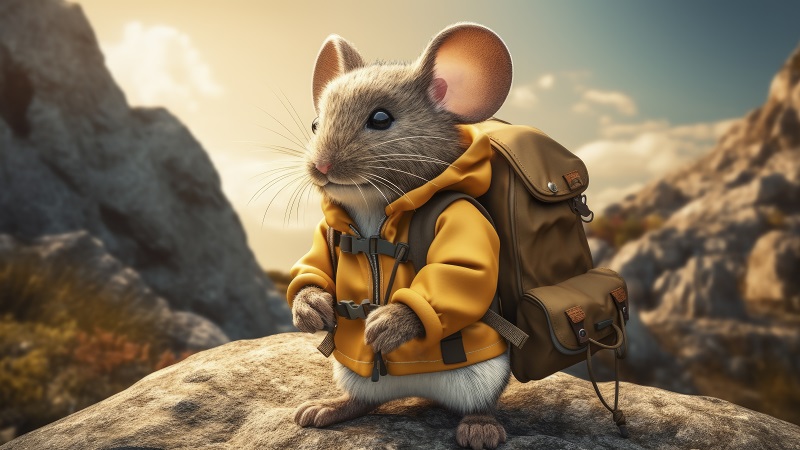What Is Animal:yzozt5bfcfa= Mouse Mice, small and unassuming, are among the most ubiquitous creatures in the world. Found on every continent except Antarctica, these tiny rodents have adapted to a wide range of environments, from dense forests to urban dwellings. Despite their size, mice play significant roles in ecosystems and have a rich history intertwined with human civilization.
Habitat and Distribution
The global distribution of mouse species
Mice are incredibly adaptable and can thrive in various habitats. They are commonly found in fields, grasslands, forests, and even urban areas. Their distribution spans across North and South America, Europe, Asia, and Africa, showcasing their ability to colonize diverse geographical regions.
Physical Characteristics
Size and weight variations
Typically small in size, mice vary in length from 2.5 to 7 inches (6 to 17 centimeters) and can weigh between 0.5 to 1 ounce (15 to 30 grams), depending on the species. Their bodies are streamlined with pointed snouts, large ears, and long tails. Compared to other rodents, such as rats, mice are generally smaller and more delicately built.
Behavioral Patterns
Nocturnal habits and activity cycles
Most species of mice are nocturnal, meaning they are primarily active during the night. This behavior helps them avoid predators and conserve energy during the day. Mice are also known for their agility and ability to squeeze through tiny openings, which aids in their survival in various habitats.
Dietary Preferences
Specific preferences in the wild versus captivity
Mice are opportunistic feeders with omnivorous diets. In the wild, they consume seeds, fruits, insects, and even small vertebrates. When living near human settlements, mice adapt their diets to include grains, vegetables, and scraps of human food, making them adaptable to urban environments.
Reproduction and Life Cycle
Survival rates of mouse offspring
Mice reproduce prolifically, with females reaching sexual maturity as early as six weeks old. Gestation periods last approximately 19 to 21 days, after which a litter of 5 to 10 pups is born. Despite their high reproductive rates, mortality rates among young mice are significant due to predation and environmental factors.
Predators and Threats
Natural enemies in the wild
Natural predators of mice include birds of prey, snakes, foxes, and domesticated animals like cats and dogs. Human activities, such as habitat destruction, pesticide use, and competition for resources, also pose significant threats to mouse populations, leading to declines in certain species.
Communication
Vocalizations and their meanings
Mice communicate using a variety of vocalizations, including squeaks, chirps, and ultrasonic calls that are beyond human hearing range. These sounds serve to warn of danger, attract mates, and establish territory within their social groups.
Ecological Role
Impact on vegetation and food chains
As prey animals, mice play a crucial role in the food chain, serving as a primary food source for many predators. They also contribute to seed dispersal and nutrient cycling in ecosystems, influencing plant growth and biodiversity in their habitats.
Domestication and Human Interaction
Cultural perspectives and symbolic meanings
Mice have a long history of interaction with humans, dating back thousands of years. While often considered pests due to their tendency to consume and contaminate food supplies, mice have also been domesticated as pets and used in scientific research for centuries. They appear in folklore, literature, and religious symbolism in various cultures worldwide.
Medical and Scientific Research
Contributions to biomedical studies
Mice are invaluable to scientific research, particularly in biomedical fields. Their genetic similarity to humans allows researchers to study diseases such as cancer, diabetes, and neurological disorders using mouse models. These studies have led to significant advancements in medical treatments and therapies.
Conservation Status
Current initiatives to protect mouse habitats
While someWhat Is Animal:yzozt5bfcfa= Mouse species are abundant and widespread, others face threats from habitat loss, pollution, and invasive species. Conservation efforts focus on protecting their natural habitats, establishing protected areas, and educating the public about the importance of mice in ecosystems.
Myths and Folklore
Stories and beliefs surrounding mice
Throughout history,What Is Animal:yzozt5bfcfa= Mouse have been depicted in folklore and mythology as symbols of fertility, agility, and even trickery. Stories featuring mice vary across cultures, highlighting their adaptability and significance in human imagination.
Interesting Facts
Unique adaptations and behaviors
- Mice have excellent senses of hearing, smell, and touch, which help them navigate their surroundings and detect predators.
- Some species of mice are known to build complex burrow systems underground, providing protection and shelter for their colonies.
- The tail of a mouse serves multiple purposes, aiding in balance, communication, and temperature regulation.
Conclusion
What Is Animal:yzozt5bfcfa= Mouse In conclusion, mice are remarkable creatures with diverse adaptations and a significant impact on both natural ecosystems and human societies. Their ability to thrive in various environments, coupled with their role in scientific research and cultural symbolism, underscores their importance in the animal kingdom.Read More Infotimedod.
FAQs About Mice:
1. What do mice eat in the wild? Mice are omnivores, consuming seeds, fruits, and insects as part of their diet.
2. How long do mice live on average? In the wild, mice typically live up to one year, while those in captivity can live up to three years.
3. Are all mice nocturnal? Yes, most species of mice are nocturnal, being most active during the night.
4. Why are mice used in scientific research? Mice are used in research due to their genetic similarity to humans and their short reproductive cycles.
